Get the Most Out of Your Zipper Bag Accessories and Add-ons
Navigating the world of zippers and their accompanying accessories can be overwhelming, whether you’re launching a clothing line, crafting handmade bags, or simply mending a beloved item. This comprehensive guide unveils the intricacies of zipper bag accessories, providing the knowledge needed to make informed choices for any project.
From understanding the different types of zipper pulls, sliders, and stops, to mastering basic zipper repair techniques and exploring creative customization, this article will provide the necessary insight. Readers will also gain practical advice on selecting the right accessories for their projects.
1. Understanding zipper bag accessories: A comprehensive overview
1.1 What are zipper bag accessories?
Zipper bag accessories encompass a wide range of components that work together to enhance both the functionality and aesthetic appeal of zippers. These aren’t just limited to bags; they’re crucial for clothing, luggage, outdoor gear, and many other items that utilize zippers. Think of them as the supporting cast for the zipper itself.
They include the parts that allow you to grasp and move the zipper (zipper pulls), the mechanism that joins or separates the zipper teeth (zipper sliders), the elements that prevent the slider from sliding off the ends of the zipper (zipper stops), and the fabric portion that the zipper teeth are attached to (zipper tape).
The term “zipper bag accessories” might also include broader bag hardware, sewing notions, fasteners, and closures that are directly related to zipper function and installation. Understanding these components is fundamental to selecting the right parts for a new project or repairing an existing one.
1.2 Types of zipper bag accessories
1.2.1 Zipper pulls
Zipper pulls are the attachments that provide a grip for operating the zipper slider. While seemingly simple, they come in a vast array of options:
- Materials: Zipper pulls can be crafted from metal (offering durability and a classic look), plastic (lightweight and available in countless colors), leather (adding a touch of luxury and often used on high-end goods), fabric (allowing for matching or contrasting with the project’s material), and nylon (durable and weather-resistant).
- Shapes and Sizes: From basic rectangular shapes to intricate designs, zipper pulls can be found in almost any form imaginable. Common sizes are designated by numbers like #3, #5, and #10, which correspond to the zipper’s gauge (size). Larger numbers indicate larger, heavier-duty zippers.
- Decorative vs. Functional: Some pulls are purely decorative, adding a unique aesthetic touch. Others prioritize function, offering an easier grip, especially for those with limited dexterity.
- Customization: For businesses, customization is a key consideration. Many suppliers offer logo integration on zipper pulls, turning a functional element into a subtle branding opportunity. YKK is a well known zipper manufacturer.
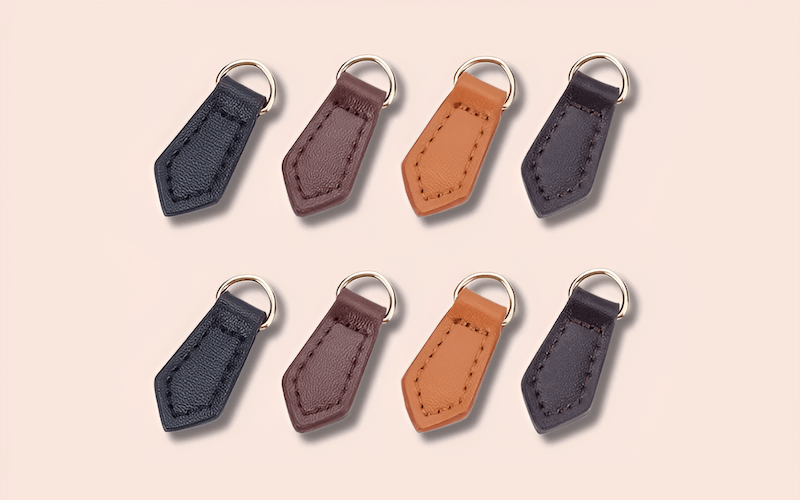
1.2.2 Zipper Sliders
The zipper slider is the component that moves along the zipper teeth, joining or separating them. Choosing the right slider is vital for smooth operation and longevity.
- Sizes and Types: Sliders are categorized by sizes that must match the zipper tape’s gauge. Common types include:
- Coil: Used with coil zippers (where the teeth are formed from a continuous coil of nylon or polyester).
- Metal: Designed for metal zippers (with individual metal teeth).
- Plastic: Used with molded plastic zippers (where the teeth are molded directly onto the zipper tape).
- Invisible: Specifically designed for invisible zippers, where the teeth are hidden behind the tape.
- Waterproof: Featuring a special seal to prevent water from penetrating the zipper.
- Gauge and Compatibility: It’s crucial to ensure compatibility between the slider and the zipper tape. The gauge (size) must match perfectly for the zipper to function correctly. Using the wrong size slider can lead to damage or malfunction.
- Durability and Smooth Operation: Slider durability is a key factor, especially for items that will see frequent use. A high-quality slider should offer smooth operation without sticking or snagging. Coats & Clark is a well known zipper manufacturer.
| Zipper Gauge | Slider Size | Common Uses |
|---|---|---|
| #3 | #3 | Lightweight garments, small pouches |
| #5 | #5 | Jackets, bags, backpacks |
| #8 | #8 | Heavy-duty bags, luggage, outdoor gear |
| #10 | #10 | Very heavy-duty applications, industrial use |
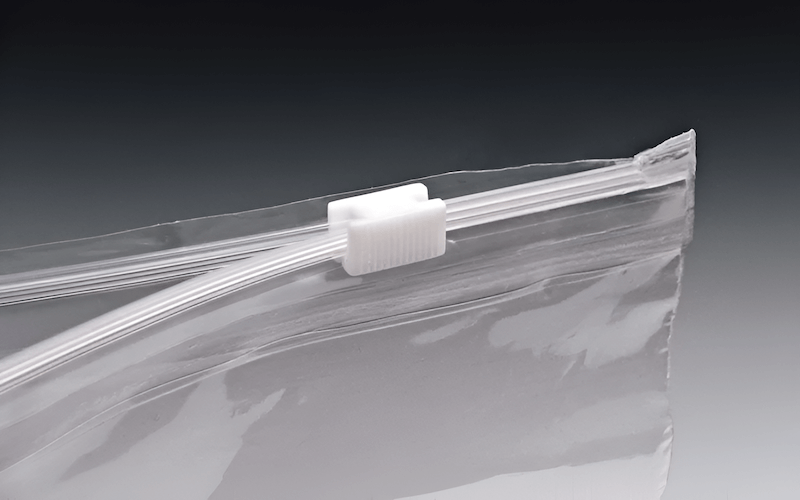
1.2.3 Zipper stops
Zipper stops are small but essential components that prevent the zipper slider from coming off the zipper chain at either end.
- Top stops: These are placed at the top of the zipper to prevent the slider from sliding off when the zipper is fully open.
- Bottom stops: These are located at the bottom of the zipper, preventing the slider from detaching when the zipper is closed.
- Differences and installation: Top stops are typically designed to be permanently attached, while bottom stops may be a single piece or two separate pieces, depending on the zipper type. Installation methods vary, but often involve crimping the stop onto the zipper tape.
- Materials: Stops are commonly made of metal (for durability) or plastic (matching the zipper type).
1.2.4 Zipper Tape
Zipper tape is the fabric portion of the zipper to which the teeth (or coil) are attached.
- Materials: Common materials include nylon (durable and water-resistant), polyester (strong and colorfast), and cotton (often used for a more natural look and feel). The choice of material often depends on the overall project and the desired aesthetic.
- Widths and colors: Zipper tape comes in various widths to accommodate different zipper gauges and project needs. A wide range of colors is available to match or contrast with the surrounding fabric.
- Continuous vs. pre-cut: Zipper tape can be purchased as continuous yardage (allowing for custom lengths) or in pre-cut lengths (convenient for standard applications). Continuous tape offers more flexibility, while pre-cut tape saves time and effort.
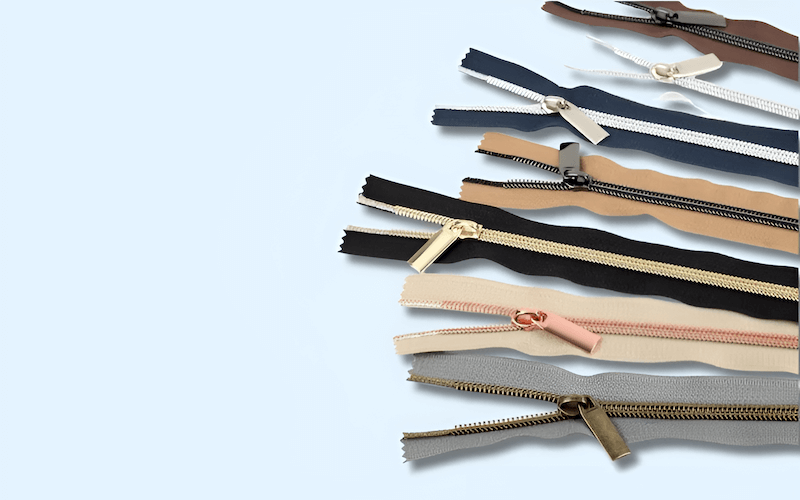
1.2.5 Zipper repair kits
Zipper repair kits are handy sets that provide the tools and components needed to fix common zipper problems.
- Typical Contents: A typical kit includes a variety of sliders, stops, zipper pliers, and other installation tools. Some kits may also include lubricant or seam rippers.
- When to Use: A repair kit is useful for addressing common zipper problems like a broken slider, missing stops, or a zipper that has become stuck. They offer a cost-effective alternative to replacing the entire zipper. Dritz is a popular brand.
1.2.6 Other accessories
Beyond the core components, several other accessories can be helpful when working with zippers:
- Zipper lubricant: This helps to keep the zipper running smoothly and prevent sticking, especially on older zippers or those exposed to the elements.
- Zipper pliers: These specialized pliers are designed for crimping zipper stops and performing other zipper-related tasks.
- Seam rippers: A seam ripper is essential for removing old zippers or correcting mistakes during installation.
- Fabric glue: Fabric glue can be used to secure zipper tape ends or to reinforce areas where the zipper is attached.
3. Choosing the right zipper accessories for your needs
3.1 Factors to consider:
Selecting the correct zipper accessories requires careful consideration of several key factors. It’s not just about picking a color or style; it’s about ensuring functionality, durability, and compatibility.
3.1.1 Project Type
The type of project significantly influences the choice of zipper accessories. A delicate garment requires different components than a heavy-duty backpack.
- Clothing: For clothing, consider the garment’s weight and style. Lightweight fabrics may call for invisible zippers or fine coil zippers with delicate pulls. Dresses, skirts, and blouses often benefit from smaller, less obtrusive accessories.
- Bags: Bags, especially those carrying heavier items, demand more robust zippers. Consider metal or heavy-duty plastic zippers with sturdy pulls.
- Luggage: Luggage requires exceptional durability to withstand the rigors of travel. Opt for large-gauge metal zippers, strong sliders, and reinforced stops.
- Outdoor Gear: Outdoor gear needs weather-resistant components. Look for waterproof zippers, nylon or plastic sliders (to avoid rust), and durable pulls that can be operated with gloves.
For example, a small clutch might use a #3 coil zipper with a decorative pull, while a large duffel bag would require a #10 metal zipper with a heavy-duty, functional pull. The specific needs vary.
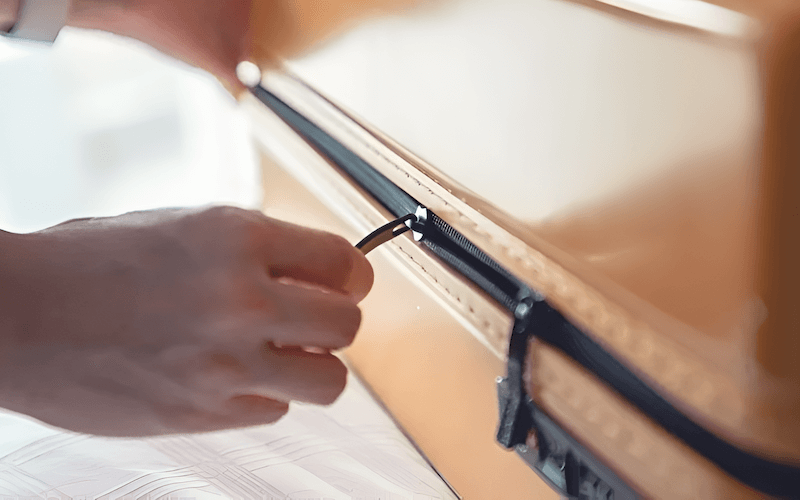
3.1.2 Zipper type
It is also important to consider the type of zipper, requiring careful attention to choose the right zipper slider.
How to identify:
- Coil: Looking closely, the coil teeth will be spiral.
- Metal: Metal will have individual teeth that are separate.
- Molded plastic: The teeth are solid plastic and quite large compared to other types.
Matching: Use the guide above to choose the right zipper.
3.1.3 Material compatibility
The materials of the zipper accessories should be compatible with each other and with the materials of the project.
- Metal Slider on Metal Teeth: This is a standard and generally reliable combination.
- Avoiding Dissimilar Metals: Avoid using dissimilar metals (e.g., a brass slider on aluminum teeth) as this can lead to corrosion over time, especially in humid environments. The interaction between different metals can cause one of them to degrade more quickly.
- Plastic and Nylon: Plastic sliders are typically used with plastic or coil zippers, and nylon sliders are often found on coil zippers as well. These combinations are generally safe and prevent the issues that can arise with dissimilar metals.
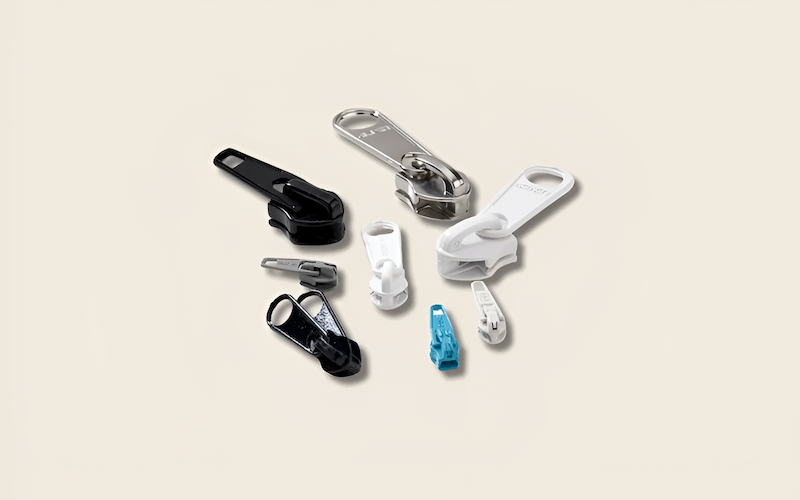
3.1.4 Durability requirements
Consider how much wear and tear the zipper will endure.
- Heavy-Duty: For items that will see frequent use or heavy loads (e.g., backpacks, workwear, luggage), choose heavy-duty zipper accessories. Look for thicker zipper tape, robust sliders, and strong stops.
- Lightweight: For items that are used less frequently or carry lighter loads (e.g., delicate garments, small pouches), lightweight accessories may be sufficient.
- YKK’s Reputation: YKK is a brand widely recognized for its reputation for producing durable, high-quality zippers and accessories. While not the only option, YKK is often a good choice when durability is a primary concern.
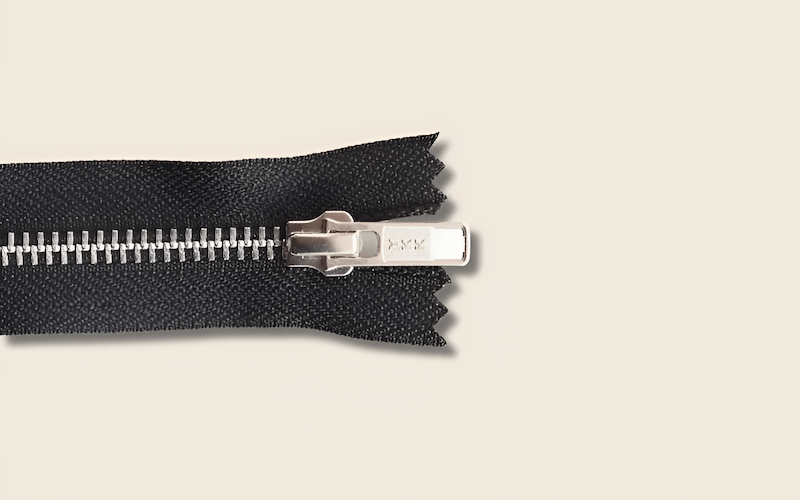
3.1.5 Aesthetic preferences
Zipper accessories can significantly impact the overall look and feel of a project.
- Style and Design: Choose accessories that complement the style and design of the item. A sleek, minimalist bag might look best with a simple metal zipper and a discreet pull, while a more elaborate bag could feature a decorative zipper pull and contrasting tape.
- Personalization: Zipper accessories offer opportunities for personalization. Consider using colored tapes, unique pulls, or even custom-designed pulls to add a personal touch.
3.1.6 Budget
Zipper accessories are available at a wide range of price points.
- Price ranges: Basic plastic accessories are generally the most affordable, while high-end metal or custom-designed options will be more expensive.
- Quality and trade-offs: Consider the trade-offs between cost and quality. Investing in higher-quality accessories may be worthwhile for items that will see a lot of use, as they will likely last longer and perform better. While a cheaper option might seem appealing initially, it could lead to premature failure and the need for repairs or replacement. There is value for money
3.2 Matching accessories to specific bag types:
The intended use of the bag or item significantly impacts the selection of zipper accessories.
3.2.1 For small businesses (Clothing/accessories)
Small businesses, particularly in the fashion and accessories industries, need to consider several factors:
- Durability and Quality: Accessories should be durable and of high quality to withstand regular use and reflect positively on the brand. Customers expect zippers to function smoothly and last a reasonable amount of time.
- Bulk Purchasing: Purchasing accessories in bulk can often lead to significant cost savings, which is essential for businesses managing their expenses.
- Branding: Zipper accessories, particularly pulls, offer a subtle but effective branding opportunity. Custom zipper pulls featuring the company logo can reinforce brand recognition.
- Reliable Suppliers: Sourcing from reliable suppliers, such as Wawak, is crucial to ensure consistent quality and timely delivery. A dependable supply chain is vital for maintaining production schedules and meeting customer demand.
- Brand Reputation: The quality of even seemingly small components like zippers can impact brand reputation. A faulty zipper can lead to customer dissatisfaction and negative reviews.
3.2.2 For DIY Enthusiasts/Hobbyists
DIY enthusiasts and hobbyists have different priorities than businesses:
- Ease of Use: Accessories should be relatively easy to use and install, as hobbyists may not have specialized tools or extensive experience.
- Variety and Creative Options: A wide variety of styles, colors, and materials allows for greater creative options. Hobbyists often enjoy experimenting with different looks and designs.
- Decorative Pulls and Colored Tapes: Decorative pulls and colored tapes are popular choices for adding personality and flair to projects.
- Online Marketplaces: Etsy and other online marketplaces are excellent resources for finding unique and handcrafted zipper accessories, offering a wider selection than traditional brick-and-mortar stores.
3.2.3 For repair needs
When it comes to zipper repair, the focus is on practicality and functionality:
- Clear instructions: Repair kits should come with clear instructions that are easy to follow, even for those with limited experience.
- Compatibility: Ensuring compatibility between the replacement parts and the existing zipper is paramount. The slider must match the zipper gauge and type.
- Readily available repair kits: Repair kits should be readily available from various sources. Popular brands like Dritz are often sold at craft stores like Joann Fabrics and online retailers like Amazon.
4. Zipper repair: A step-by-step guide
4.1 Common zipper problems
Before diving into repairs, it’s helpful to identify some of the most frequent zipper issues:
- Broken Slider: The slider may break, crack, or simply wear out over time, making it difficult or impossible to operate the zipper.
- Stuck Zipper: The zipper may become stuck due to dirt, debris, fabric caught in the teeth, or lack of lubrication.
- Separated Teeth: The zipper teeth may separate, either partially or completely, preventing the zipper from closing properly.
- Missing Stops: The top or bottom stops may come off, allowing the slider to slide off the zipper chain.
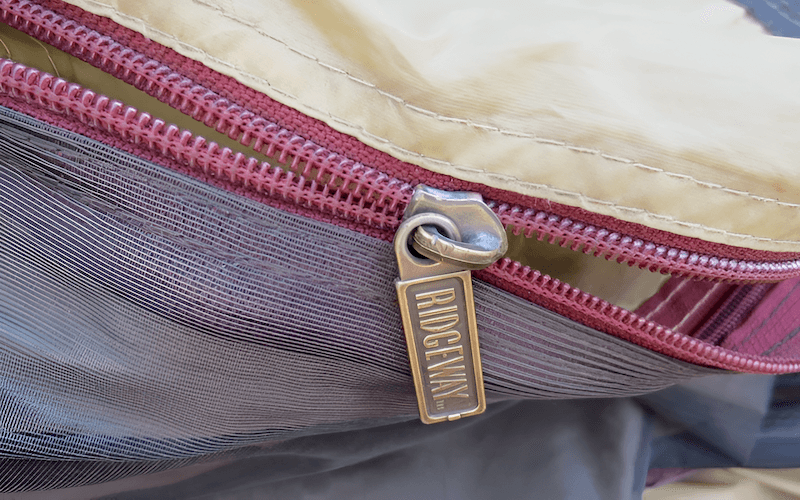
4.2 How to replace a zipper slider
Replacing a zipper slider is a common repair that can often save a garment or bag from being discarded.
- Identify the Zipper Gauge and Type: Determine the size (#3, #5, #8, #10, etc.) and type (coil, metal, plastic) of the existing zipper. This information is crucial for selecting the correct replacement slider.
- Remove the Old Slider: If the top stops are metal, use zipper pliers to carefully pry them open. If there are no top stops, or if they are plastic, you may be able to slide the old slider off the top of the zipper. If the slider is completely broken, you may need to cut it off with pliers.
- Prepare the New Slider: Ensure the new slider is the correct size and type. Open the slider slightly by pulling the pull tab up.
- Thread the Slider onto the Zipper Tape: Carefully thread one side of the zipper tape into the top opening of the slider. Then, thread the other side of the tape into the other opening. This can be tricky, and it may take a few tries to get both sides aligned correctly.
- Test the Slider: Once both sides of the tape are in the slider, gently pull the slider down to engage the teeth. Test the zipper several times to ensure it’s working smoothly.
- Replace the Top Stops (if necessary): If you removed metal top stops, use zipper pliers to crimp new top stops onto the tape, just above the slider.
4.3 How to fix a stuck zipper
A stuck zipper can often be remedied without replacing any parts.
- Inspect the Zipper: Check for any obvious obstructions, such as fabric caught in the teeth, dirt, or debris.
- Apply Lubricant: Apply a small amount of lubricant to the zipper teeth. Suitable lubricants include:
- Zipper-specific lubricant: These are designed specifically for zippers and are often available at sewing or craft stores.
- Graphite pencil: Rub the lead of a graphite pencil along the zipper teeth.
- Bar soap: A small amount of dry bar soap can also work as a lubricant.
- Wax candle: Similar with bar soap
- Gently Work the Slider: Gently try to move the slider up and down. Avoid forcing it, as this could damage the teeth or the slider.
- Repeat if Necessary: If the zipper remains stuck, repeat the lubrication and gentle movement steps.
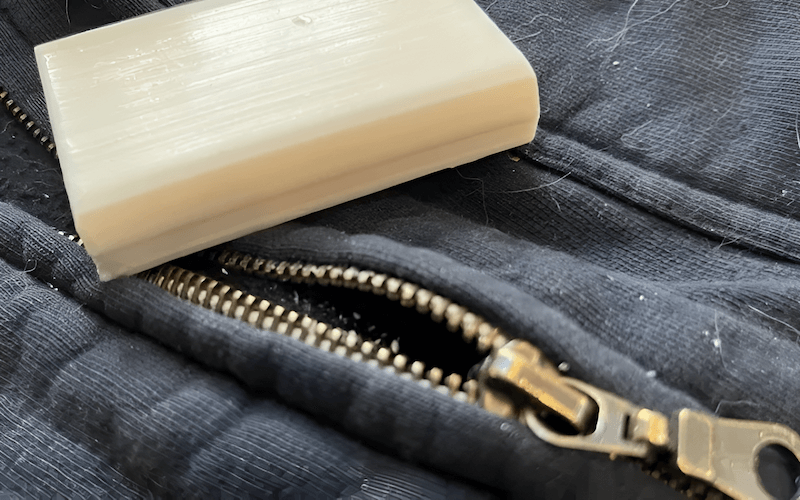
4.4 How to reattach zipper teeth
Reattaching zipper teeth is sometimes possible, but it depends on the extent of the damage.
When Possible: If only a few teeth have become misaligned or slightly separated, it may be possible to reattach them.
When Replacement is Necessary: If the teeth are severely bent, broken, or missing, or if a large section of the zipper has separated, complete replacement of the zipper is usually the best option.
Reattachment (if feasible):
- Use pliers to carefully realign any bent teeth.
- Slide the slider down past the separated section.
- Carefully realign the separated teeth, ensuring they interlock correctly.
- Slowly pull the slider up over the reattached teeth. This may take some patience and finesse.
4.5 How to replace zipper stops
Replacing zipper stops is a relatively straightforward repair.
Top Stops:
- Remove the Old Stop (if necessary): If the old top stop is still present, use zipper pliers to carefully pry it open and remove it.
- Position the New Stop: Place the new top stop on the zipper tape, just above the slider, ensuring it’s aligned correctly.
- Crimp the Stop: Use zipper pliers to firmly crimp the new top stop onto the tape. Make sure it’s securely attached and won’t slide off.
Bottom Stops:
- Remove the Old Stop (if necessary): If the old bottom stop is a single piece, you may need to use pliers or a seam ripper to remove it. If it’s a two-piece stop, you can usually separate the pieces.
- Position the New Stop: Place the new bottom stop (or the two pieces) at the bottom of the zipper tape, where the teeth end.
- Crimp or Secure the Stop: If it’s a single-piece bottom stop, use zipper pliers to crimp it onto the tape. If it’s a two-piece stop, you may need to sew it in place or use fabric glue to secure it.
4.6 When to seek professional help
While many zipper problems can be fixed at home, some situations warrant professional attention:
- Complex Repairs: If the zipper is severely damaged, or if the repair involves intricate stitching or alterations, it’s best to consult a professional tailor or seamstress.
- Valuable Items: If the item with the damaged zipper is valuable, either sentimentally or monetarily, it’s wise to entrust the repair to a professional to avoid causing further damage.
- Lack of Experience: If you’re uncomfortable attempting the repair yourself, or if you lack the necessary tools or experience, seeking professional help is always a good option.
5. Customizing your bags with zipper accessories
Zipper accessories offer a fantastic opportunity to personalize and enhance the aesthetic appeal of bags, clothing, and other items. They allow for creative expression and can elevate a simple design to something truly unique.
5.1 Adding decorative zipper pulls
One of the easiest and most impactful ways to customize a bag is by adding decorative zipper pulls. These come in a vast array of shapes, sizes, materials, and designs.
- Variety of Styles: From whimsical charms and colorful beads to sleek metal designs and personalized initials, there’s a decorative pull to suit every taste and style. Consider the overall aesthetic of the bag and choose pulls that complement or enhance it.
- Easy Installation: Most decorative pulls simply attach to the existing zipper slider with a small loop or clasp, making them incredibly easy to swap out and update.
- Different: Decorative zipper pulls often have features such as animals, flowers, or favorite items such as cars, motorbikes, etc.
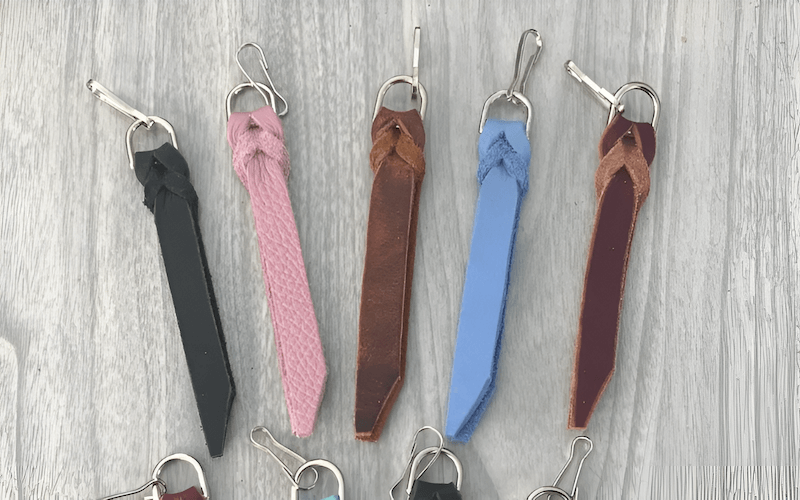
5.2 Using different zipper tape colors
Changing the zipper tape color is another way to add a pop of personality or create a contrasting design element.
- Contrast and Coordination: Choose a tape color that contrasts with the bag’s fabric for a bold look, or opt for a coordinating color for a more subtle effect.
- Matching and Blending: You can also use colored tape to match a specific design element within the bag’s fabric or to blend the zipper seamlessly into the overall design.
- Color: Usually basic colors, easy to coordinate with bag colors, are popular
5.3 Creating custom zipper pulls
For a truly unique touch, consider creating custom zipper pulls. This allows for complete creative control and the ability to perfectly match the bag’s design or branding.
- DIY Options: There are many DIY methods for creating custom pulls, including using beads, charms, polymer clay, resin, fabric scraps, or even repurposed materials.
- There are no limits to customizing zipper pulls.
5.4 Branding with zipper accessories (for businesses)
For businesses, zipper accessories offer a valuable branding opportunity.
Logo Integration: Custom zipper pulls featuring the company logo are a subtle yet effective way to reinforce brand recognition and add a professional touch.
Working with suppliers, this is a great choice.
6. Where to buy zipper bag accessories?
Finding the right place to purchase zipper bag accessories depends on individual needs, budget, and desired level of customization. Several options are available, each with its own advantages:
Online Retailers:
- Amazon: Offers a vast selection of zipper accessories from various brands and sellers, often at competitive prices. Convenient for comparing options and reading reviews.
- Etsy: A great source for unique, handcrafted, and custom-made zipper pulls and other accessories. Ideal for finding one-of-a-kind items and supporting independent artisans.
Craft and Fabric Stores:
- Joann Fabrics: Carries a wide range of zippers, pulls, repair kits, and other sewing notions, suitable for both basic and more advanced projects.
- Michaels: Similar to Joann Fabrics, offering a variety of zipper accessories and crafting supplies.
Specialty Zipper Suppliers:
- Wawak: A well-known supplier to the sewing and garment industry, offering a comprehensive selection of zippers, accessories, and tools, often at wholesale prices. Ideal for businesses and those needing bulk quantities.
- ZipperShipper: Specializes in zippers and related components, providing a wide variety of options and expert advice.
Other stores
- Tom Bihn: Well known brand.
- GE Designs: Offers a big collection of zipper.
ByAnnie: Providing useful items
Recommendation: Consider consulting with experts at stores for the best advice.
Guide: Use the information in this article to make your purchase decision.
7. Related questions
Here are some frequently asked questions related to zipper bag accessories:
7.1 What is the difference between a #3 zipper and a #5 zipper?
The number refers to the zipper’s gauge, which is a measurement of the zipper teeth’s size. A #3 zipper is smaller and lighter than a #5 zipper. #3 zippers are commonly used on lightweight garments and small pouches, while #5 zippers are more suitable for jackets, bags, and backpacks. Larger numbers indicate larger, heavier-duty zippers.
7.2 How do I know what size zipper slider I need?
The slider size must match the zipper gauge. Look for a number (e.g., #3, #5, #8, #10) on the back of the existing slider. If there’s no number, or you’re replacing the entire zipper, you’ll need to measure the width of the zipper teeth when the zipper is closed. This measurement, in millimeters, roughly corresponds to the zipper gauge. Refer to a zipper size chart for precise measurements.
7.3 Can I use a metal slider on a coil zipper?
No, it’s generally not recommended. Metal sliders are designed for metal zippers, and coil sliders are designed for coil zippers. Using the wrong type of slider can damage the zipper teeth or cause it to malfunction. Always match the slider type to the zipper type.
7.4 How to choose a zipper for each type of fabric?
- Lightweight fabrics (silk, chiffon, lace): Use fine-gauge coil zippers (#3 or smaller) with delicate sliders and pulls. Invisible zippers are also a good option.
- Medium-weight fabrics (cotton, linen, denim): Choose #5 coil or plastic zippers.
- Heavy-weight fabrics (canvas, leather, upholstery): Opt for #8 or #10 metal or heavy-duty plastic zippers.
7.5 How can I prevent my zipper from rusting?
To prevent rust, avoid using dissimilar metals (e.g., a brass slider on aluminum teeth). If the zipper will be exposed to moisture, consider using a waterproof zipper or applying a zipper lubricant that contains a rust inhibitor. Store items with zippers in a dry place.
7.6 How to sew zippers on clothes?
There are many different types of sewing, such as concealed zippers, exposed zippers, and fly-front zippers.
- Concealed Zipper: Sew between 2 layers of fabric, used for skirts and dresses.
- Exposed Zippers: Used to highlight design, color
- Fly-Front Zipper: Common in pants
Read more:
- History of Zipper Bags: From 1950s to Now – Packlove
- Custom Zipper Bags with Logo: Boost Your Brand
- Zipper Bag Care: Tips for Long – Lasting Use
Zipper bag accessories, though often small, play a crucial role in the functionality, durability, and aesthetics of countless items. From the basic components like pulls, sliders, stops, and tape to repair kits and decorative embellishments, understanding these elements empowers informed decision-making, whether launching a product line, pursuing a hobby, or simply maintaining beloved belongings.
By carefully considering factors such as project type, material compatibility, durability requirements, and aesthetic preferences, you can select the perfect accessories to ensure zippers perform flawlessly and enhance the overall design. With the knowledge of common zipper problems and their solutions, you will not need to worry about fixing them.
Visit our website https://mypacklove.com/ to explore our product options and request a quote. Contact us today to discuss your specific needs! Let us help you enhance your clothing care and branding efforts.






















